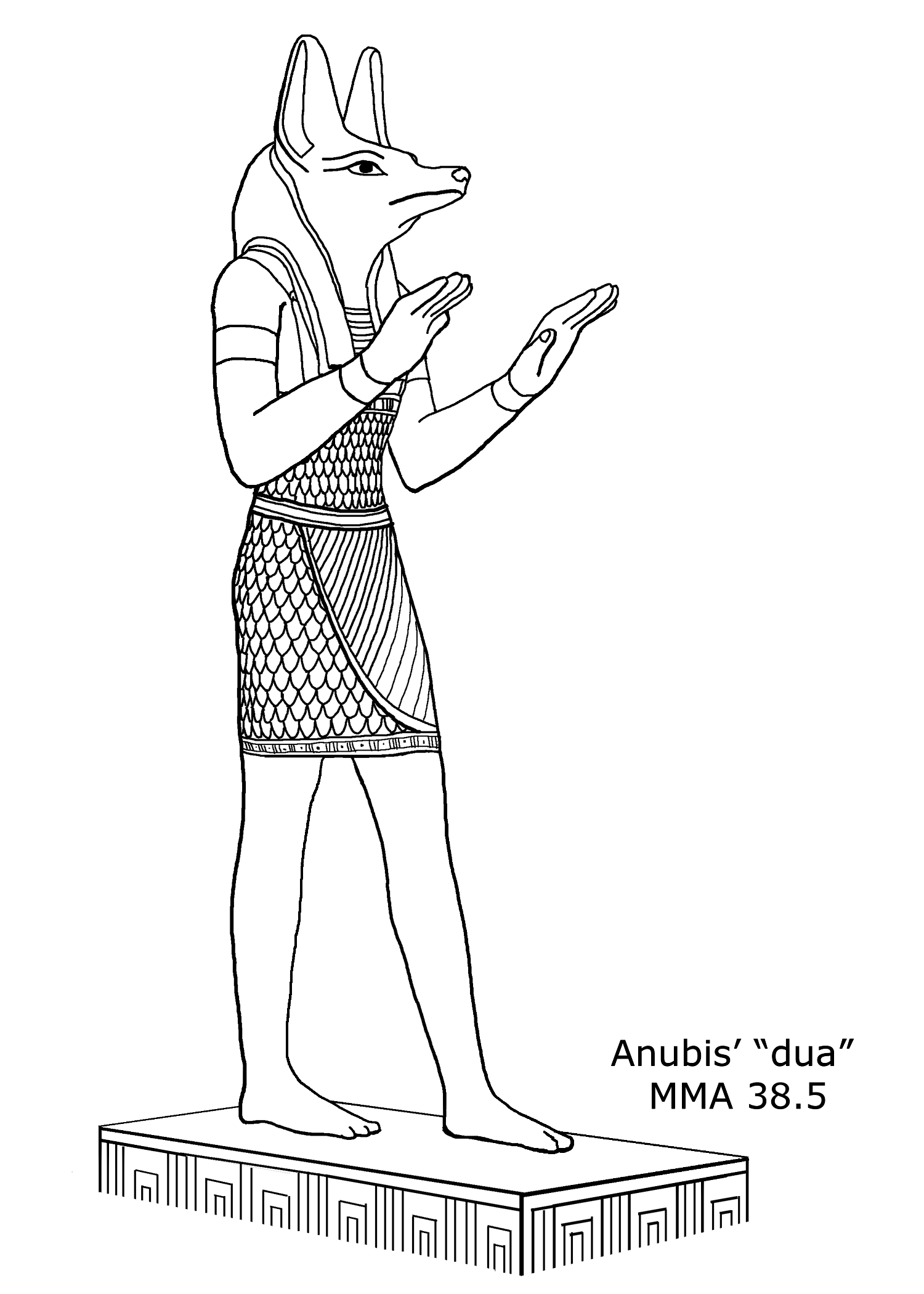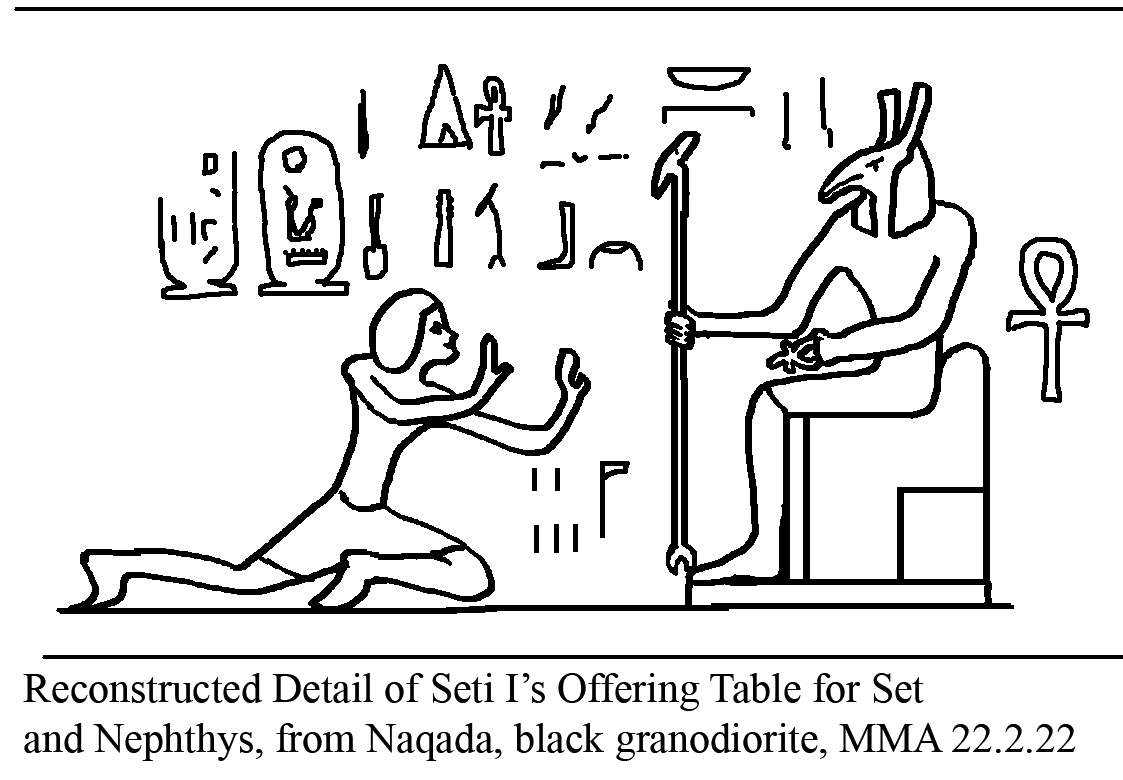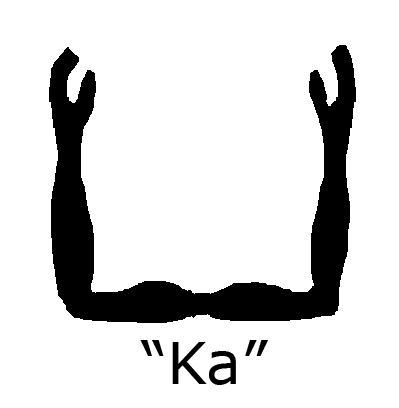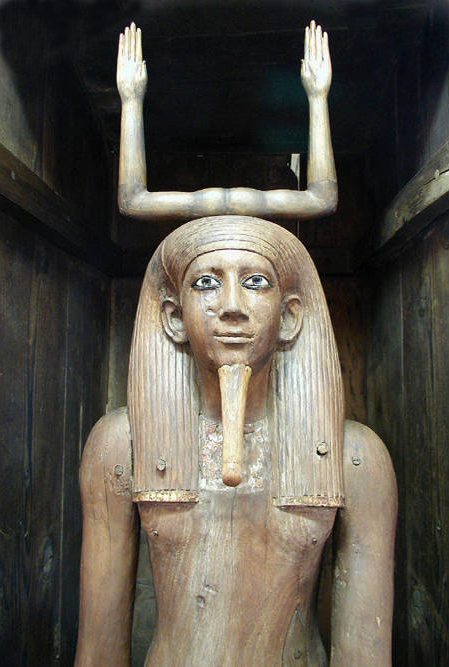June 24, 2012

Anubis' "dua" at the Metropolitan Museum, #38.5, , traced from Museum website photo of the statue.

Seti I gives Set "dua"
Reconstructed Detail of Seti I's Offering Table for Set and Nephthys, MMA 22.2.22
Wilkinson shares a grayscale version of the museum photo in his _Reading Egyptian Art_. He explains, "The Ptolemaic painted wooden statue of Anubis in New York's Metropolitan Museum of Art (ill.3) illustrates the actual position of the arms in this gesture. Along with ill. 2, it also reiterated the fact that even gods could adopt this post before deities..." (Page 29)
"In the written language the hieroglyph was used as a determinative in such words as iau: 'praise', dua: 'adore', suash: 'extol,' and ter: 'to show respect,' so the gesture's range of meanings is perfectly clear to us." (Ibid.)
However, I think there are subtle meanings beyond these.
First off, imagine seeing the three-dimensional statue of Anubis from above. What position does his hands hold? They are in the positions of the "ka" glyph:

The Ka is an aspect of the soul, the vital life force,
and "in all periods it is used as a term for the creative and sustaining power of life" (REA, page 49)

Copyright-free photo of Hor Aubibre's Ka statue from Wikipedia, via Jon Bodsworth
At Egyptian Museum, Cairo. Main floor - gallery 11. Wood: height 170 cm, width 27 cm. JE 30948 - CG 259.
I go to the Pyramid texts to learn more about "dua". While it encompasses the idea of worship, it has a broader meaning. It means a communion with the gods, in which we feed on their essence. This concept survives into Christian times. Remember the Last Supper, in which Jesus "took bread, and blessed, and brake it; and he gave to the disciples, and said, ‘Take, eat; this is my body.’" (Matthew 26:26-28) The bread, having been blessed, contained his essence, and by consuming it, the disciples would take this essence into them.
But let's go back to earlier times. Pepi I is exhorted, "You shall feed on the gods' food on which they feed." (_The Ancient Egyptian Pyramid Texts_, translated by James P. Allen and Peter Der Manuelian (2005 Society of Biblical Literature), page 105)
Unis is also equipped:
"Someone has gone with his ka:
Horus has gone with his ka; Seth has gone with his ka;
Thoth has gone with his ka; the god has gone with his ka;
Osiris has gone with his ka; Eyes-Forward has gone with his ka;
you too have gone with you ka.
Ho, Unis! Your ka's arm is before you. Ho, Unis! Your ka's arm is after you.
Ho, Unis! Your ka's foot is before you. Ho, Unis! Your ka's foot is after you." (TAEPT, pg. 28)
Unis gets more explicit instructions:
"Unis's little finger, dig out this which is in Osiris' navel, and Unis will not thirst, Unis will not hunger: it will not be against the heart of Unis. Ha's arms are
what repel his hunger.
Become awash (with joy)! Become awash, hearts!" (TAEPT, pg. 28)
Becoming 'awash' suggests complete satisfaction. Pepi I is assured, "Your abundance is from the gods' marsh, from which they feed..." (TAEPT, pg. 106)
Unis
"lives on the evolution of every god, who eats their bowels when they have come from the Isle of Flame with their belly filled with magic.
Unis is an equipped one who has gathered his effectiveness..."(TAEPT, pg. 51)
"Unis' privileges will not be taken from him, for he has swallowed the Perception of every god."(TAEPT, pg. 52)
"
Allen and Der Manuelian give this translation, "Unis has reappeared in the sky and is crowned as lord of the Akhet," whereas Samuel Mercer gives, "N. is the 'hm-falcon, who surpasses the 'hm-falcons, the great falcon." (_The Pyramid Texts_, translated by Samuel A.B. Mercer, first published 1952, Longmans, Green, 1952, Original from the University of Michigan, ForgottenBooks.org)

Taking in the gods' essence means, "When you go, Horus goes; when you speak, Seth speaks..."(TAEPT, pg. 105) Thusly, Pepi I is 'akhified' and become fully effective. His ka will go on to continue the work he set in motion while he was incarnate.
No doubt he communed with the gods while incarnate so he could have the power to rule and insure that Ma'at would be brought about. For that is the primary role of the King, to ensure Ma'at is maintained. If there is injustice, he works to overcome it. Thus, balance is restored and isfet (injustice, untruth and destructive chaos) is defeated.
So these Old Kingdom kings' souls became akhs, and when we remember them, we feed their Kas. We can do that for all the akhu whose lives we honor. As the Egyptians say "That which is remembered lives . . ." (From the Book of the Dead). One akhu I especially like to remember is that of Prince Khaemwaset. "The First Egyptologist" "'loved to restore the monuments of the kings, making firm again what had fallen into ruin'" "because he loved the noble ones who dwelt in antiquity before him, and the excellence of everything they made, in very truth, a million times." (Quotes from ancient texts found in John Ray's _Reflections of Osiris: Lives from Ancient Egypt_, pages 87-88 At one of his restoration projects, Khaemwaset asks others to continue his work, "'Remember my name in (your) decrees...'"(page 90) So we remember, and as we study the excellent art of the ancient Egyptians, we are carrying forth the objectives Khaemwaset set in motion nearly 3000 years ago. The power with which he sent forth his message is Heka, and so we can hear it strongly today.
Robert Ritner describes Heka: "As the pre-eminent force through which the creator engendered and sustained the ordered cosmos, it was necessarily the dynamic 'energy' which Egyptian religious ritual sought to channel that it might effect its identical goal, the preservation of the creator's universe. The cultic manipulation of this 'energy' by recitation, substance, and ritual thus constituted a sophisticated system of 'practical theology,' a 'theurgy' in which the priest quite literally 'performed the works of god.'" (_The Mechanicals of Ancient Egyptian Magical Practice_, page 247)
Thus, communication with the gods is a circular exchange of energy. We take in their essence, which feeds our Ka, and also allows the gods to work through us, which in turn feeds their Ka.